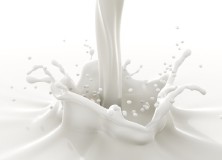
For years, the dairy industry has touted its products as good for bones due to the relatively high levels of calcium they contain. Putting aside for the moment the fact that there are many nondairy sources of calcium that offer other benefits to health (e.g., leafy greens), the link between dairy intake and bone health is mostly theoretical. Now, a large cohort study in Sweden has provided evidence that not only does milk intake not prevent bone fractures, it may actually increase fracture incidence in women. Further, the study suggests that greater milk intake is associated with increased mortality in both sexes.
In the study, as reported in the British Medical Journal, researchers looked at the self-reported milk intake of two large cohorts: one of over 45,000 men and another of over 61,000 women. For up to 20 years, the researchers tracked fracture incidence and mortality in both cohorts. They found that milk had no effect on fracture risk in males, but that increased milk intake slightly increased the risk of hip fractures in females (HR = 1.09).
What was perhaps even more surprising was the finding that those who drank more milk had a large increase in mortality risk. Compared with women who drank less than one glass of milk per day, those who drank three glasses or more had a mortality hazard ratio of 1.93, meaning they were nearly twice as likely to die. The researchers found that every glass of milk consumed added to the risk of mortality, though the effect was more pronounced in females.
The researchers found this association only with milk consumption, as opposed to other dairy products. In fact, they found that women with high intakes of cheese or fermented milk products had lower mortality and fracture rates compared with women with lower intakes of these products. For each additional serving, the rate of mortality and hip fractures was reduced by 10 to 15%.
So why the difference? Why would milk alone cause deleterious health effects while yogurt and cheese seem to prevent them? The researchers’ hypothesis is that the causative agent for milk’s negative effects on health is D-galactose, which makes up half of the disaccharide lactose (the other half is glucose). Galactose has been linked to several health impacts in animals, including oxidative stress, chronic inflammation, neurodegeneration, decreased immune response, and shortened life span. In fact, introducing galactose by diet or injection is an established animal model of aging. Accordingly, the researchers in the present study found a positive association between milk intake and both urine 8-iso-PGF2α (a biomarker of oxidative stress) and serum interleukin 6 (an inflammatory biomarker).
On the other hand, yogurt and cheeses contain little to no lactose or galactose, thanks to the activity of bacteria on these sugars. While the presence of galactose is not the only difference between these dairy products and milk, the current findings are at least consistent with the idea that galactose may underlie the negative health impact of milk.
Reference
Michaelsson K, et al. Milk intake and risk of mortality and fractures in women and men: cohort studies. BMJ 2014;349:g6015 (published online 28 October 2014).


